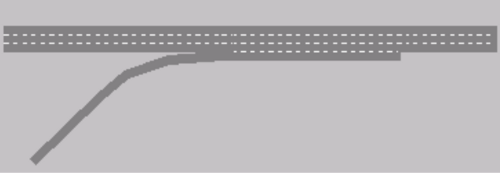Merging lanes and lane reduction
To model driving behavior at acceleration lanes and lane reduction, it is best to define links as merging lanes.
- Make sure the weaving section is a link with the following properties:
Number of lanes = Number of lanes on main link + number of merging lanes
- Make sure that after the weaving section there is only one connector to the main link. For a realistic graphical representation, add a dummy link at the end of the merging lane. This will make reduction of the lanes less abrupt. Do not use a connector for this link.
- Make sure the through traffic is following a route, so that it does not switch to an acceleration lane. This route must end no sooner than on the link after the merging lane. Downstream of the merging lane, the value of the Lane change distance of the connector must be greater than the weaving section length (Attributes of connectors). If this is not the case, a vehicle on the main link may change to the acceleration lane and thus to the weaving section. It will then need to change back to the main link. This kind of behavior produces unrealistic lane changes.
- The routes of the merging traffic must not end at the weaving section, but extend beyond it. If not, the interweaving traffic will not know that it needs to change lanes before the end of the merging lane in order to get on the main link.
Example of a one-lane link merging into a three-lane link.
Merging section in normal display mode:

Merging section in wireframe display mode:

Superordinate topic:

